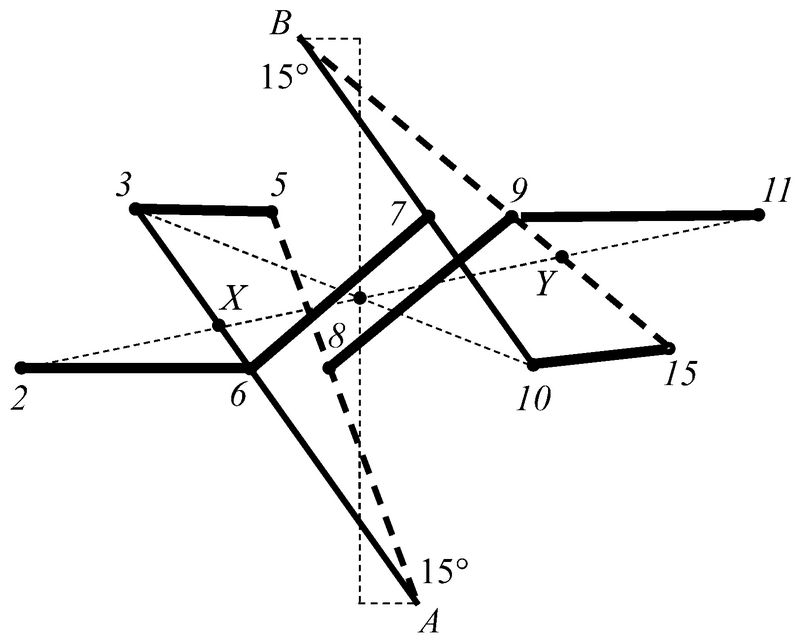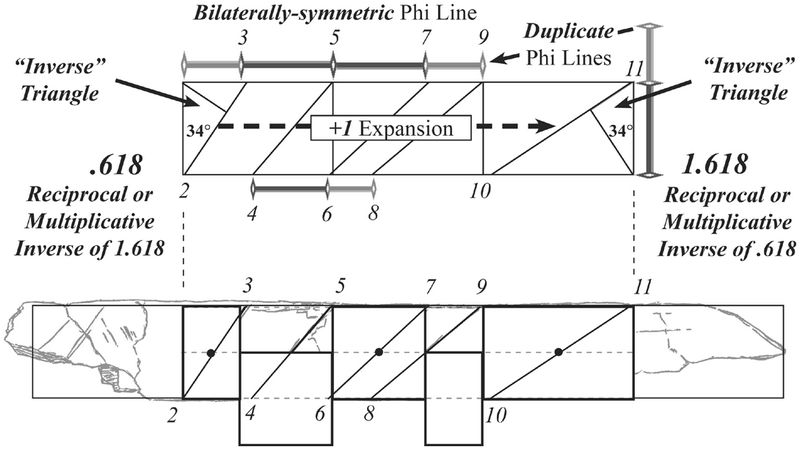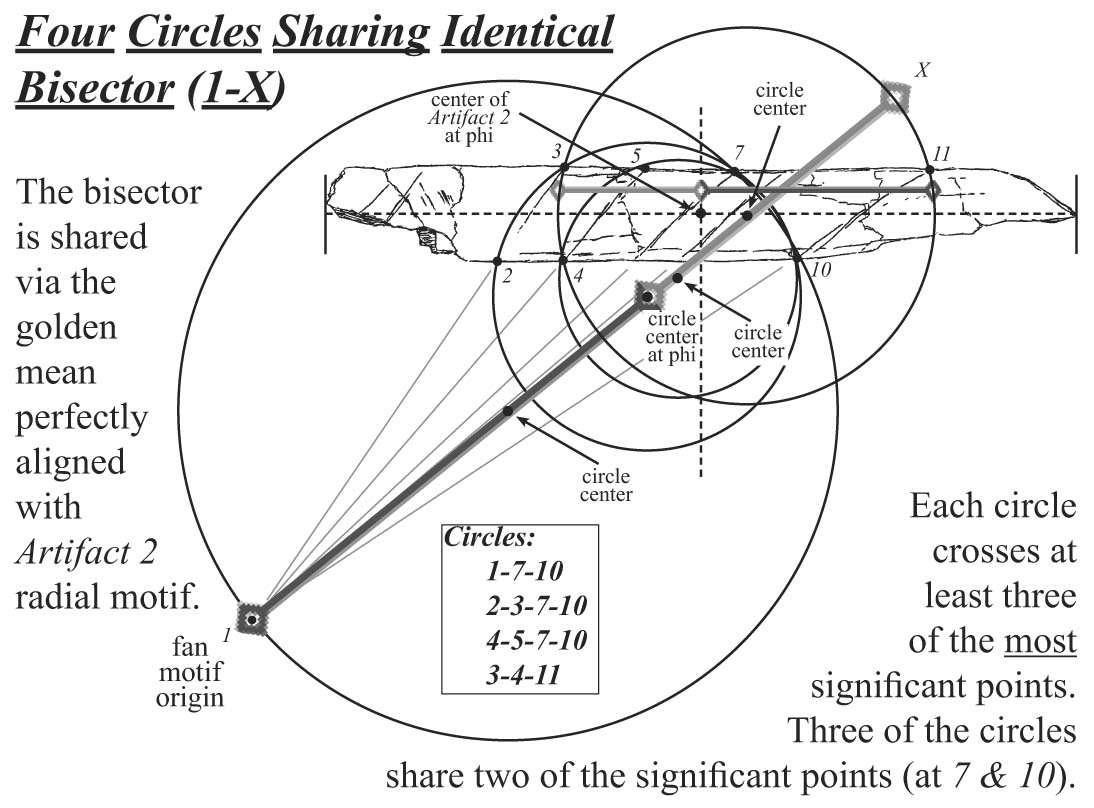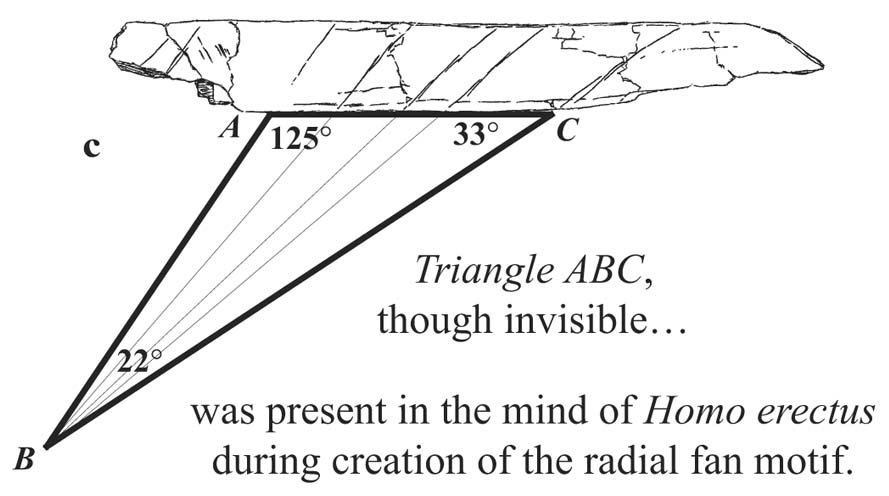|
| However, skeptics
were not budged. For them, evolutionary predispositions are so
engrained as to prevent them seeing anything other than crude
scratches by ape people barely conscious in the modern sense of the
word. There are no attempts to perceive Gestalts because in this
community there is simply no place for them.
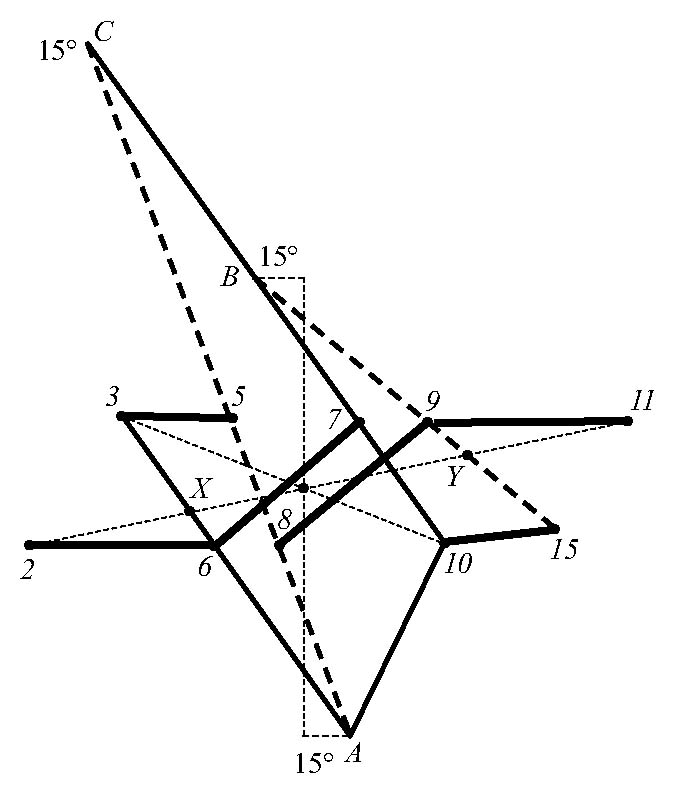
Instead, and
unbelievably so, critics actually compare the profound Bilzingsleben
engravings to the work of chimpanzees. This is despite the fact that
the artifacts are from a context including such markers as:
“microlithic” tools; wood, bone and antler tools; huts and campfires.
Fig. 7. A completed Gestalt interpretation of Artifact 2 as seen partially in Fig. 1 presented as Slide #46 of 112 at the XV UISPP Congress, 2006. Note that angles A, B, and C are all 15�.
This study along with 50 similar was censored from publication for five
years by the UISPP (International Union of Prehistoric and
Protohistoric Sciences) as well as by Elsevier’s Journal of Human Evolution—as
the team of anonymous reviewers under physical anthropologist and
editor Susan Anton, NYU, deemed it of no scientific value. Of course,
their non-scientific motive is
clear to anyone understanding the religious nature of the evolutionary
paradigm. This study and all of the other studies presented in The Graphics of Bilzingsleben were not treated by JHE as empirical evidence which must be taken into account while assessing the intelligence of Homo erectus but as a threat to the paradigm. However, I wish to publicly state that I did not submit the studies to JHE to
taunt them but because of recommendation by leading anthropologist
Randall White, Anthropology, NYU, who was already aware of the corrupt
actions of the UISPP. It was White who first mentioned anthropology’s
problems in 1995 when my first geometries were censored by Current Anthropology.
White was followed by other authorities. Since anthropology’s agendas
have cultural repercussions outside of anthropology they must be fought
especially since they include aggressive promotion of a religion as science.
But this is how
blinkered perception is engendered when scientific ideology
becomes religious. For habitual lack of objectivity, that ideology has
spread through the entire scientific community blitzing out critical
thinking as it spreads. Even intelligent people are afraid to challenge
an ideology with backing from a seemingly unanimous academic hive and
are further dissuaded by the added deterrent of fanatics such as
outspoken biologist Richard Dawkins who publicly demean anyone
challenging the ideology through use of propaganda techniques such as
name-calling or ad hominem.
The defense against challenging evidence is this crude because it is not seen as a part of scientific process but as a threat
to the paradigm. Real science, of course, doesn’t behave this way. The
evolutionary community is in trouble on many fronts despite how few
realize it and evidence against cognitive evolution is not one of the
fronts they were prepared to defend, hence, their only
alternative—suppression of evidence.
Why is evidence against cognitive evolution so feared? It is because acknowledging modern-human level creativity in Homo erectus
people releases them from their use as transitional ape-people; and
once that happens the evolutionary community is left with little more
than a few enigmatic bones of prehistoric apes and humans held up to
support a six million-year evolutionary sequence. Have no concern
regarding genetics either; since they have not been able to produce
indisputable fossils they attempt to build cases analogically in bits.
No scientist should ever accept atomistic proxies to fill in for
missing Gestalts. When one ‘hominid’ is debunked, they simply change
focus to another (See, Ardi: How to Create a Science Myth, PCN #3). It is part of a history of promoting an un-testable paradigm through diversion.
When The Graphics of Bilzingsleben provided systematic geometric evidence that the engravings were made by intelligent people the studies were immediately
censored as there is little means to counter the idea of prehistoric
geometers in the light of straight edge proofs. Lines created by use of
a straight-edge are impossible to attribute to apes or even ape men. As
quoted in Part 1, Proof of straight edge use by Homo erectus, it was predicted to the author in advance
after the evidence was presented at the XV UISPP Congress that the
archaeology community would do everything in it’s power to discredit
the studies as they demonstrated by falsifiable means the community’s
error in its assessment of Homo erectus.
One final word on Bilzingsleben Gestalts. The tolerances
applied are not only transparent but many of the claims hold true even
if the images are altered. If one goes so far as to change various line
lengths or certain point position interpretations or otherwise distorts
the images the special qualities are often simply pushed to another
location. It is similar to how a fossil clam distorted through
metamorphosis is still easily recognized as a clam. This is the concept
of Gestalt. The unity of the configurations is high and possibly
well-thought-out and tested on wood before committed to the archival
medium of bone. Possible draft versions on wood might also explain why
these engravings appear to have, for the most part, no errors or
corrections.
John
Feliks has specialized in the study of
early human cognition for nearly twenty years using an approach based
on geometry and techniques of drafting. Feliks is not a mathematician;
however, he uses the mathematics of ancient artifacts to show that
human cognition does not evolve. One aspect of Feliks' experience that
has helped to understand artifacts is a background in music; he is a
long-time composer in a Bach-like tradition as well as an acoustic-rock
songwriter and taught computer music including MIDI, digital audio
editing, and music notation in a college music lab for 11 years.
|
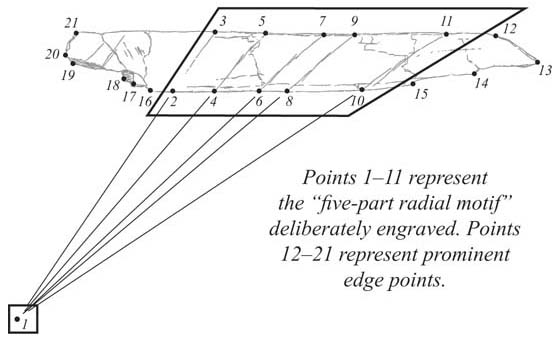 cience/philosophy greats of the past such as Plato,
Bacon, Descartes, Newton) allows no room for exploration of meaning or
even awareness of possible larger structures that extend beyond the
sums of parts—like working a jigsaw puzzle with the unreasonable
stipulation that one may look only at the pieces and not consider that
there might actually be a picture.
cience/philosophy greats of the past such as Plato,
Bacon, Descartes, Newton) allows no room for exploration of meaning or
even awareness of possible larger structures that extend beyond the
sums of parts—like working a jigsaw puzzle with the unreasonable
stipulation that one may look only at the pieces and not consider that
there might actually be a picture.